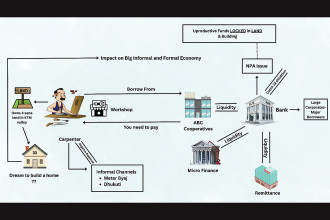
Production processes before the 18th century was largely manual and created by the skilled artisan using their hands. This was a slow and time-consuming process requiring considerable efforts of human power. Products were customised to meet the client's needs.
Human ingenuity enabled the creation of new inventions through science and technology and this impacted the ways and means of running businesses and industries. A series of industrial revolutions took place on the backbone of these innovations. Application of technology in industries helped to produce in scale of economies, reducing costs and enhancing efficiency in production.
The first industrial revolution started late 18th century with the invention of the steam engine and the application of mechanisation in textile production. Steam power enabled the transportation of goods in large volumes, thereby replacing the outdated method of transportation by using animal and human power. Mechanisation of industries made it possible to produce in a large scale.
The second revolution started in the late 19th century and remained till the early 20th century. This period of industrialisation was based on the use of electricity, assembly lines, and use of telecommunication facilities. The ultimate impact was the reduction in the cost of production.
The third generation of industrialisation remained for almost half a century starting from the 1950s, and was based on the automation of industries and the use of electronics, computers, and digital technologies. The internet became the backbone of digital operations and means of information and communication during this period.
Further advancement of technologies based on the internet and digitalisation gave rise to the fourth industrial revolution since the beginning of the 21st century. Also known as Industry 4.0, the current stage of industrialisation is being driven by Artificial Intelligence, the Internet of Things (IoT), Robotics, 3D printing, and the use of big data, among others.
Automation of production processes and service delivery lie at the heart of the fourth generation of the industrial revolution.
Nepal has made substantial progress toward digitalisation and automation of government services. Department of Customs was the pioneer of the automation process with the introduction of Automated Systems of Customs Data (ASYCUDA) during the latter half of the 1990s. Internet infrastructure was strengthened with the laying of optical fibre over the last two decades. Now, the internet penetration in the country has reached 65% but there is a big gap in the availability of services. Only 30% of people in rural areas have access to the facilities while coverage in the urban population has reached 85%. Mobile penetration has reached almost 300% of the population and 40% use smartphones.
Policy and legal reform have also started since the beginning of this century. The Government of Nepal bought out the Long-Term Plan of Information, and Communication Sector in 2002. Other policies in the ICT sector include: Telecom Policy-2003, ITPolicy-2015, Broadband Policy-2014, and National Cyber Policy-2023, among others.
A framework programme of Digital Nepal was launched in 2019 with the objectives of creating a knowledge-based society, focusing on a digital economy, and achieving the social and economic development objectives through the optimum use of digital technology for simplification and facilitation of public service delivery.
The Parliament enacted the Electronic Transaction Act (ETA) in 2006 and the government bought out its regulation in 2007. A comprehensive revision in the ETA-2006 has been proposed in the Information Technology Act which is under the consideration of the Parliament.
Nepali industries are in the primary stage concerning the use and application of modern technologies in their operations. Manufacturing industries like cement, noodles, yarn and drugs, among others, have started automation based on the application of the Internet of Things (IoT). The use of robotics, big data, and artificial intelligence is virtually non-existent. Logical use of big data, available on the internet would have multifold advantage that helps the user to solve complicated problems. Industries could use those advanced technologies for managing periodic maintenance, improving energy efficiency, increasing equipment and machinery performances, and building good customer relationships. The use of artificial intelligence and robotics helps to reduce the cost of production.
The adoption of Industry 4.0 in Nepal is not easier than said. There are inherent problems in the adoption of modern technologies. First, there is a big gap in the availability of services, the so-called digital divide, between the urban and rural areas. Second, the number of IT-related human resources is not sufficient to support the development and sustenance of the services. A large number of young people are temporarily migrating outside the countries in quest of remunerative job opportunities. These include all kinds of young workforce: skilled, semi-skilled and unskilled. This resulted in the lack of human resources to work in all sectors; agriculture, manufacturing, and services. Third, supply of the electricity for running the manufacturing units is not reliable and predictable. Fourth, most of the production units in the country fall under the micro, cottage, and small, industries (MCSI) category, not being able to afford the technology due to their tiny size. They largely rely on manual workforce and in most cases family members are employed in running the units. Fifth, digitisation is adopted in only limited sectors of the economy and is not widespread among the government, public, and private economic entities. Sixth, the regulatory regime is not conducive to making big investments in digital technology. The current legislation and the institutional arrangements are not sufficient to address the issues of data protection, cyber theft, cyberbullying, and other form of cybercrimes. Seventh, there are no government incentives and motivation for industries to adopt modern technologies in their operations. All industries are getting the same treatment irrespective of their mode of operation.
Modernising industries, particularly the manufacturing sector, is important from the perspective of creating new job opportunities and aligning the economy on a new growth trajectory. The cautionary tale says that the advances in AI and robotics technology are likely to eliminate a large number of jobs. Hence, reconfiguring and creating new jobs for the displaced human resources and the new entrants in the job market should be a priority for the government. This requires careful planning, training, and retraining of the workers to take up new roles and responsibilities. Proper incentives for adopting modern technologies, creating robust physical and digital infrastructures, adequate institutional and legal arrangements for data security, and controlling cybercrime are crucial for enabling an IT-enabled ecosystem in the country.
The Government of Nepal should develop a comprehensive plan for taking the industries and manufacturing sector to a new height by nurturing and facilitating the use of ICT-based technologies, and the need for micro, cottage and small industries should be given due priority in the plan. This could be one of the important policy measures to incentivise the young workforce to seek decent job opportunities within the country.





-1758271497.jpg)
